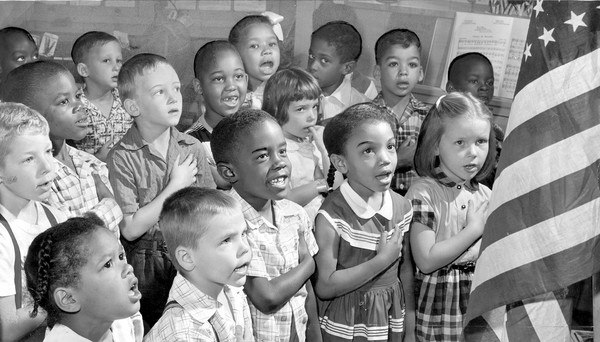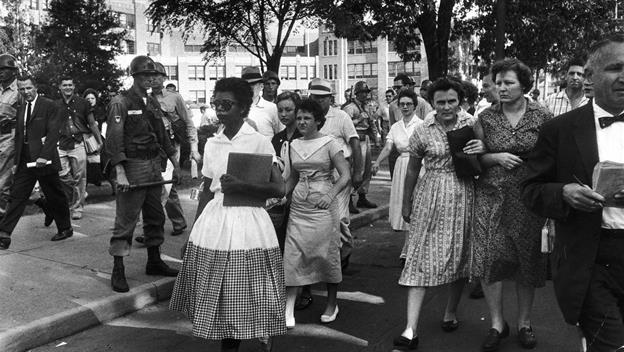The Color Purple Contents
The American Civil Rights movement
Walker’s personal involvement in civil rights
Alice Walker’s involvement with the American civil rights movement began when she was attending college in the early part of the 1960s. As a social and political activist she has continued to use her writing to speak out for human dignity, civil rights and freedom from injustice and discrimination. Walker’s work has made her one of the most significant African-American writers of her generation.
The Color Purple (1982) has been described as a ‘perfect emancipation novel’. To understand its political and social impact, it is also necessary to study its historical context and to remember that Walker was not only a supporter of civil rights, but also an active participant in some of the incidents outlined below.
A brief timeline (1954 – 1968)
School segregation (1954)
In the 1950’s, school segregation was widely accepted throughout America. Black and white pupils attended separate schools and colleges and most of the Southern states had legislated to prevent integrated schooling for black and white pupils.
 In 1954 a landmark legal case, Brown v. Board of Education of Topeka, Kansas, was heard in the Supreme Court and segregation was unanimously declared to be unconstitutional.
In 1954 a landmark legal case, Brown v. Board of Education of Topeka, Kansas, was heard in the Supreme Court and segregation was unanimously declared to be unconstitutional.
The murder of Emmet Till (1955)
The result of the Brown case was a violent backlash against black citizens by gangs of whites who committed beatings, burnings and lynchings. Many incidents went unpunished because all-white juries refused to convict white people for killing blacks.
In 1955 a black teenager, Emmet Till, was murdered while visiting relatives in Mississippi, because he ‘spoke flirtatiously’ to a white woman in a store. The woman’s husband and brother kidnapped Till, whose mutilated body was found three days later in the Tallhatchie River. Despite overwhelming evidence, based on eye-witness testimony, the husband and brother were found not guilty of the crime by an all-white, all-male jury.
The Montgomery bus boycott (1955)
Rosa Parks, a 43-year-old black woman, was arrested in Montgomery, Alabama, for refusing to give up her seat near the front of a bus to a white man. Fifty black church and community leaders including a Baptist minister, Dr Martin Luther King, Jr. met at Dexter Avenue Baptist Church and decided to organise a boycott of public transport. The Montgomery Bus Boycott caused a 65% drop in the company’s profits and led to another piece of Supreme Court legislation that declared bus segregation was unconstitutional.
Little Rock High School (1957)
Little Rock Central High in Arkansas decided to abolish segregation and admit black students. On the first day of term, nine black students arrived at Central High and were prevented from entering the building. The State Governor had ordered the Arkansas National Guard to monitor the school, but they and the students faced a mob of 1,000 white protesters. After several days of unrest, President Eisenhower ordered 1,000 paratroopers and 10,000 National Guardsmen to Little Rock, and on September 25th Little Rock Central High School was finally desegregated.
The ‘Sit-in’ Campaign (1960 onwards)
Black people were not allowed to eat alongside white customers in restaurants, so in Greensboro, North Carolina, several black students staged a ‘sit-in’ at a Woolworth’s store ‘whites-only’ lunch counter. They were refused service, but went back day after day. Eventually, they were joined by more students, both black and white and over the next few weeks there were non-violent protests by young people across America.
Despite beatings, heavy court fines, arrests and imprisonments, the protests continued for several months. John F Kennedy who was elected President that year, sent a statement to sit-in students in Atlanta saying that they had ‘shown that the new way for Americans to stand up for their rights is to sit down’.
Freedom Rides (1961)
Although segregation on public transport had been declared unconstitutional in 1955, the ruling was largely ignored in the South. Volunteers of both races decided to challenge this by changing places on public transport. Black and white passengers sat in one another’s seats on buses and used opposite toilet facilities in depots. The campaign was met with violence and many freedom riders were arrested.
President Kennedy intervened and threatened to send in federal troops unless the Democratic governors over the South stopped using violence against protesters. The Supreme Court also tightened the legislation regarding desegregated transport.
James Meredith (1962)
James Meredith was the first black student to enrol at the University of Mississippi. When he attempted to enter the campus, escorted by National Guard soldiers, a riot broke out and two people were killed. Meredith's admission to University in his own right as a citizen of the United States is regarded as an important moment in the history of civil rights. Despite harassment, he went on to graduate with a degree in political science.
Violence in Birmingham, Alabama (1963)
Birmingham, Alabama was one of the most severely segregated cities in the south and in 1963, black men and women protesters held sit-ins at lunch counters where they were refused service and also ‘kneel-ins’ on the steps of churches where they were refused entrance. Dr King and seven other black church ministers were arrested, fined and jailed for leading a protest march that was met with policemen and dogs.
In retaliation for the protests, the Ku Klux Klan bombed the Sixteenth Street Baptist Church and killed four young black girls who were getting ready to lead the morning service. By the end of the day riots and fires had broken out throughout the town and another two teenagers were dead.
The march on Washington and Dr King’s ‘I Have a Dream’ speech (1963)
Shocked by the violence in Alabama, civil rights organisers organised a public march and peaceful demonstration in Washington DC, the centre of American government. Two hundred thousand civil rights demonstrators packed the city and listened to Dr Martin Luther King’s historic ‘I Have a Dream’ speech. The event came to symbolise the whole civil rights movement. Alice Walker attended this event and writes about its effect on her in much of her non-fictional work.
Assassination of President John F Kennedy (1963)
On November 22nd 1963, President Kennedy was shot and killed during a visit to Dallas, Texas. The Vice President, Lyndon Johnson, a Texan, was sworn in as the next President of the United States the same day.
The Civil Rights Act (1964)
In his first address to Congress as U S President, Lyndon Johnson called for the passage of a civil rights bill, in memory of former President John F Kennedy. After a long debate and a massive lobbying campaign in Washington by civil rights leaders of all faiths and skin colour, the bill was finally signed into law and African-Americans could no longer be excluded from restaurants, hotels and other public facilities.
‘Bloody Sunday’ – the Selma to Montgomery march (1965)
Black citizens organised a march from Selma to Montgomery, the state capital of Alabama, to protest against police brutality and to call attention to the struggle for black suffrage. As the demonstrators crossed the bridge leading out of Selma, they were met by state troopers and told to turn back. When the protesters refused, the officers used tear-gas and attacked the crowd. Fifty people were injured and the ‘Bloody Sunday’ incident was televised around the world.
Two further marches were organised and led by Dr King, after which President Johnson gave a speech in support of civil rights to the U S Congress. As a result the Voting Rights Act was passed.
The Voting Rights Act (1965)
The Voting Rights Act prohibited literacy tests and poll taxes being imposed on black citizens who wished to register to vote in elections. In the South, these illegally imposed restrictions had effectively barred many African-Americans from their constitutional rights. After the Act came into force, the numbers of registered black voters rose dramatically, especially in the South.
Assassination of Martin Luther King, Jr. (1968)
In April 1968, Dr. Martin Luther King Jr. was shot by a sniper while standing on the balcony at the Lorraine Motel in Memphis, Tennessee.
King had previously led a march in Memphis in support of striking black sanitation workers, which had ended in violent clashes with police and the death of one of the protesters. King’s second visit was to attempt to lead a peaceful protest. After the assassination, violence broke out as many black supporters took to the streets across the United States in a massive wave of riots.
By the time of Dr King’s death, violence had edged its way into the civil rights movement. Black Panther Party members carried loaded weapons; riots had erupted across the country; and numerous civil rights organizations had taken up the mantra of ‘Black Power’.
Recently Viewed
Scan and go

Scan on your mobile for direct link.